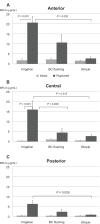Assessment of vitreous drug concentration in the porcine eye following intracameral injection or irrigation with moxifloxacin
- PMID: 23874080
- PMCID: PMC3711953
- DOI: 10.2147/OPTH.S47629
Assessment of vitreous drug concentration in the porcine eye following intracameral injection or irrigation with moxifloxacin
Abstract
Introduction: Posterior capsule rupture causes instant vitreous contamination, resulting in endophthalmitis. However, transfer of intracameral moxifloxacin (MFLX) to the vitreous has not been examined in detail. We investigated vitreous antibiotic concentrations following intracameral MFLX in both ruptured and intact posterior capsular eyes.
Methods: Experiment 1: Intraocular lenses were inserted into 21 extracted porcine eyes by one of the following three methods: (1) Irrigation: Throughout surgery, 33-fold diluted MFLX irrigation solution (150 μg/mL) was used; (2) Bag and chamber flushing: After surgery, the anterior chamber and area behind the intraocular lenses were irrigated with 30-fold diluted MFLX (167 μg/mL) using a 5 mL syringe; (3) Simple injection: Tenfold diluted MFLX (50 μg in 0.1 mL) was injected intracamerally at the conclusion of surgery. The eyeballs were frozen and the anterior, central, and posterior portions of the vitreous were cubed. After defrosting, concentrations were measured using high-performance liquid chromatography. Experiment 2: The same procedure was conducted for 18 eyes in which the posterior capsule had been ruptured.
Results: Experiment 1: Transfer of intracameral MFLX to the anterior vitreous was approximately 1% (1.56-2.20 μg/mL) regardless of the administration method. Experiment 2: MFLX reached a high concentration in the vitreous with irrigation solution administration (maximum 30.22 μg/mL). The concentrations reached by simple injection or flushing were significantly less than those obtained by irrigation.
Conclusion: With an intact posterior capsule, intracameral MFLX exhibited limited effects on vitreous concentration. Despite the fact that the risk of infection clearly increases in cases of ruptured capsule, no special infection prevention protocol has been proposed. It was confirmed that irrigation solution caused vitreous contamination in ruptured eyes within only a short irrigation time. In this case, intracameral administration did not necessarily achieve preventive concentrations for endophthalmitis, but it appears that an effective drug concentration can be achieved in the vitreous by the administration of irrigation solution.
Keywords: intracameral injection; irrigation; moxifloxacin; posterior capsular rupture; vitreous concentration.
Figures


Similar articles
-
Comparison between intracameral moxifloxacin administration methods by assessing intraocular concentrations and drug kinetics.Graefes Arch Clin Exp Ophthalmol. 2013 Aug;251(8):1955-9. doi: 10.1007/s00417-013-2294-7. Epub 2013 Apr 2. Graefes Arch Clin Exp Ophthalmol. 2013. PMID: 23546399
-
Bag and chamber flushing: a new method of using intracameral moxifloxacin to irrigate the anterior chamber and the area behind the intraocular lens.Graefes Arch Clin Exp Ophthalmol. 2013 Jan;251(1):81-7. doi: 10.1007/s00417-012-2098-1. Epub 2012 Jul 3. Graefes Arch Clin Exp Ophthalmol. 2013. PMID: 22752223
-
Safety of intracameral injection of moxifloxacin using total replacement technique (bag and chamber flushing).J Ocul Pharmacol Ther. 2014 Nov;30(9):771-6. doi: 10.1089/jop.2014.0029. Epub 2014 Aug 21. J Ocul Pharmacol Ther. 2014. PMID: 25144127 Clinical Trial.
-
Posterior capsulorhexis combined with optic buttonholing: an alternative to standard in-the-bag implantation of sharp-edged intraocular lenses? A critical analysis of 1000 consecutive cases.Graefes Arch Clin Exp Ophthalmol. 2008 Jun;246(6):787-801. doi: 10.1007/s00417-008-0779-6. Epub 2008 Apr 19. Graefes Arch Clin Exp Ophthalmol. 2008. PMID: 18425525 Free PMC article. Review.
-
Perioperative Antibiotics to Prevent Acute Endophthalmitis after Ophthalmic Surgery: A Systematic Review and Meta-Analysis.PLoS One. 2016 Nov 8;11(11):e0166141. doi: 10.1371/journal.pone.0166141. eCollection 2016. PLoS One. 2016. PMID: 27824933 Free PMC article.
References
-
- Hatano H. Experimental Pseudomonas endophthalmitis in rabbits. Intracameral inoculation of two pseudomonal strains. Nippon Ganka Gakkai Zasshi. 1982;86(8):839–845. Japanese. - PubMed
-
- Suzuki T, Wada T, Kozai S, Ike Y, Gilmore MS, Ohashi Y. Contribution of secreted proteases to the pathogenesis of postoperative Enterococcus faecalis endophthalmitis. J Cataract Refract Surg. 2008;34(10):1776–1784. - PubMed
-
- Al-Mezaine HS, Al-Assiri A, Al-Rajhi AA. Incidence, clinical features, causative organisms, and visual outcomes of delayed-onset pseudophakic endophthalmitis. Eur J Ophthalmol. 2009;19(5):804–811. - PubMed
-
- Endophthalmitis Study Group, European Society of Cataract and Refractive Surgeons Prophylaxis of postoperative endophthalmitis following cataract surgery: results of the ESCRS multicenter study and identification of risk factors. J Cataract Refract Surg. 2007;33(6):978–988. - PubMed
-
- O`Brien TP, Arshinoff SA, Mah FS. Perspectives on antibiotics for postoperative endopthalmitis prophylaxis: potential role of moxifloxacin. J Cataract Refract Surg. 2007;33(10):1790–1800. - PubMed
LinkOut - more resources
Full Text Sources
Other Literature Sources

